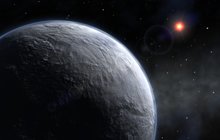Exoplanets
The search for planets outside our Solar System
The search for planets outside our Solar System constitutes a key element of what is possibly the most profound question for humanity: is there life elsewhere in the Universe? ESO's observatories are equipped with a unique arsenal of instruments for finding, studying and monitoring these so-called 'exoplanets', or 'extrasolar planets'.
Using the Very Large Telescope (VLT), astronomers were able for the first time to spot the faint glow of a planet outside our Solar System, taking the first ever picture of an exoplanet (see ESO Press Releases eso0428 and eso0515). This new world is a giant one, some five times more massive than Jupiter. This observation marks a first major step towards one of the most important goals of modern astrophysics: to characterise the physical structure and chemical composition of giant and, eventually, terrestrial-like planets. See ESO Press Release eso0507. The VLT has also played a crucial role in the discovery of a system of seven Earth-sized planets orbiting a star just 40 light-years away, TRAPPIST-1. Three of the planets lie in the habitable zone and could harbour oceans of water on their surfaces, increasing the possibility that the star system could play host to life. This system has both the largest number of Earth-sized planets yet found and the largest number of worlds that could support liquid water on their surfaces. See ESO Science Release eso1706.
With HARPS, the High Accuracy Radial velocity Planet Searcher, astronomers discovered no fewer than four planets orbiting a nearby star with masses below that of Neptune, including a two Earth-mass planet — the smallest ever discovered — and a seven Earth-mass planet that resides in its star's habitable zone. This planet orbits its host star in about 66 days. Astronomers think that this planet is covered by oceans — a waterworld. This discovery marks a groundbreaking result in the search for planets that could support life. See ESO Science Release eso0915. Also with the aid of HARPS, astronomers have found clear evidence of a planet orbiting the closest star to Earth, Proxima Centauri. This rocky world, a little more massive than Earth, has a temperature suitable for liquid water to exist on its surface. See ESO Science Release eso1629.
Another telescope at La Silla, using an innovative technique known as microlensing, worked as part of a network of telescopes scattered across the globe. This collaboration discovered a new extrasolar planet significantly more Earth-like than any other planet found so far. The planet, which is only about five times as massive as the Earth, circles its parent star in about 10 years, and most certainly has a rocky/icy surface. See ESO Science Release eso0603.
A special brochure on extrasolar planets is available.
